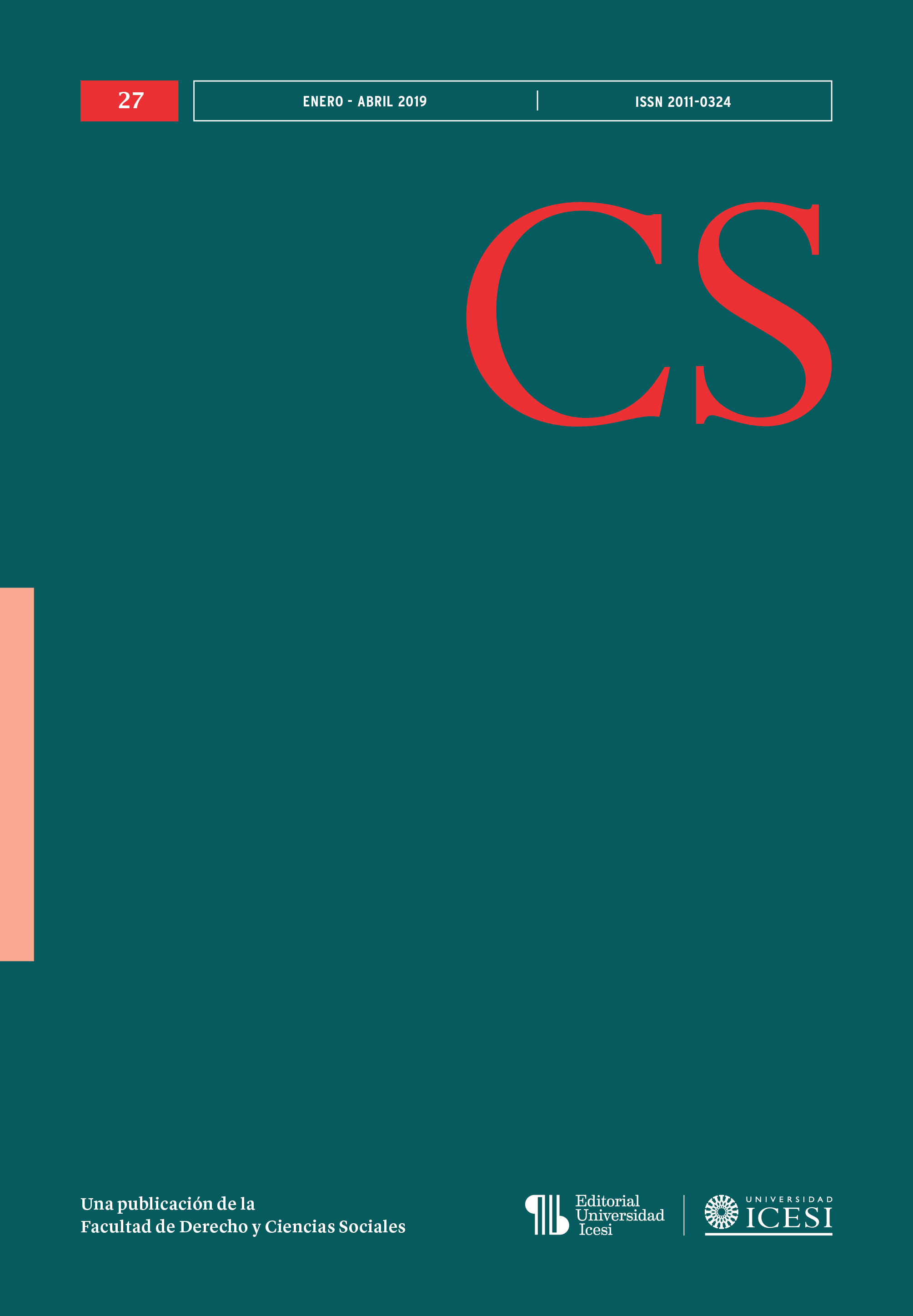Revisión narrativa de la relación entre envidia y Schadenfreude
DOI:
https://doi.org/10.18046/recs.i27.3049Palabras clave:
Schadenfreude, envidia, relaciones sociales, comparación social, merecimientoResumen
Envidia y Schadenfreude son emociones negativas. La envidia promueve la comparación social y el deseo de tener lo que otro tiene y Schadenfreude implica el procesamiento de recompensas desde el placer por la desgracia de quien es envidiado; ambas son contraproducentes en las relaciones sociales. Esta revisión narrativa se basa en el estado del arte de la relación entre envidia y Schadenfreude. Hizo un recorrido por los conceptos y retomó estudios experimentales desde la psicología social y la neurociencia. La conclusión señaló que la literatura revisada se centra en cuatro factores que relacionan envidia y Schadenfreude en: 1) la activación cerebral, 2) las condiciones sociales, 3) la empatía, y 4) el sistema de méritos. Adicionalmente, la literatura mostró la posibilidad de que la envidia sea un predictor de Schadenfreude, lo que posibilitaría nuevas investigaciones para demostrar esta hipótesis.
Descargas
Referencias
Aristóteles (1941). The Basic Works of Aristotle. New York: Random House.
Baez, S., Pino, M., Berrío, M., Santamaría-García, H., Sedeño, L., García, A. M… e Ibáñez, A. (2017). Corticostriatal Signatures of Schadenfreude: Evidence from Huntington’s Disease. Journal of Neurology, Neurosurgery, and Psychiatry, (89), 112-116. https://doi.org/10.1136/jnnp-2017-316055
Baez, S., Santamaría-García, H., Orozco, J., Fittipaldi, S., García, A. M. y Pino, M. (2016). Your Misery is no Longer my Pleasure: Reduced Schadenfreude in Huntington’s Disease Families. Cortex, (3), 78-85. https://doi.org/10.1016/j.cortex.2016.07.009
Baudelaire, C. (1956). The Essence of Laughter and Other Essays, Journals, and Letters. New York: Meridian Books.
Bietti, L. M. (2009). Disonancia cognitiva: procesos cognitivos para justificar acciones inmorales. Ciencia Cognitiva, 3(1), 15-17.
Brigham, N., Kelso, K., Jackson, M. y Smith, R. (1997). The Roles of Invidious Comparisons and Deservingness in Sympathy and Schadenfreude. Basic and Applied Social Psychology, 19(3), 363-380. https://doi.org/10.1207/s15324834basp1903_6
Cialdini, R. B., Thorne, A., Borden, R. J., Walker, M. R., Freeman, S. y Sloan, L. R. (1976). Basking in Reflected Glory: Three (Football) Field Studies. Journal of Personality and Social Psychology, 34(3), 366-375.
Cikara, M. y Fiske, S. T. (2013). Their Pain, Our Pleasure: Stereotype Content and Schadenfreude. Annals of the New York Academy of Sciences, 1299(1), 52-59. https://doi.org/10.1111/nyas.12179
Cukier, R. (2012). Psicosociodrama de la envidia: ¡el que pueda que tire la primera piedra! Psicoterapia y Psicodrama, 1(1), 21-35.
Dvash, J. y Shamay-Tsoory, S. G. (2011). Envy and Schadenfreude: The Neural Correlates of Competitive Emotions. En From DNA to Social Cognition (pp. 139-155). Hoboken, NJ: John Wiley & Sons. https://doi.org/10.1002/9781118101803.ch9
Feather, N. T. (1992). Values, Valences, Expectations, and Actions. Journal of Social Issues, 48(2), 109-124. https://doi.org/10.1111/j.1540-4560.1992.tb00887.x
Feather, N. T. y Sherman, R. (2002). Envy, Resentment, Schadenfreude, and Sympathy: Reactions to Deserved and Undeserved Achievement and Subsequent Failure. Personality and Social Psychology Bulletin, 28(7), 953-961. https://doi.org/10.1177/014616720202800708
Freud, S. (1919). Das Unheimliche. Imago. Zeitschrift für Anwendung der Psychoanalyse auf die Geisteswissenschaften, (5), 297-324.
Greenier, K. D. (2015). Seeing You Fall Vs Taking You Down: The Roles of Agency and Liking in Schadenfreude. Psychological Reports: Relationships & Communications, 3(116), 941-953. https://doi.org/10.2466/21.PR0.116k31w7
Gromet, D. M., Goodwin, G. P. y Goodman, R. A. (2016). Pleasure from Anothers Pain: The Influence of a Targets Hedonic States on Attributions of Immorality and Evil. Personality and Social Psychology Bulletin, 42(8), 1077-1091. https://doi.org/10.1177/0146167216651408
Hareli, S. y Weiner, B. (2002). Dislike and Envy as Antecedents of Pleasure at Another’s Misfortune. Motivation and Emotion, 26(4), 257-277. https://doi.org/10.1023/A:1022818803399
Heider, F. (1958a). Ought and Value. En The Psychology of Interpersonal Relations (pp. 218-243). Hoboken, NJ: John Wiley & Sons. https://psycnet.apa.org/doiLanding?doi=10.1037%2F10628-000
Heider, F. (1958b). Perceiving the Other Person. En The Psychology of Interpersonal Relations (pp. 20-58).
Hoboken, NJ: John Wiley & Sons. https://psycnet.apa.org/doiLanding?doi=10.1037%2F10628-002
Hickman, T. y Ward, J. (2007). The Dark Side of Brand Community: Inter-group Stereotyping, Trash Talk, and Schadenfreude. Advances in Consumer Research, (34), 314-319. http://www.acrwebsite.org/volumes/12923/volumes/v34/NA-34
Jankowski, K. F. y Takahashi, H. (2014). Cognitive Neuroscience of Social Emotions and Implications for Psychopathology: Examining Embarrassment, Guilt, Envy, and Schadenfreude. Psychiatry and Clinical Neurosciences, 68(5), 319-336. https://doi.org/10.1111/pcn.12182
Leach, C. W., Spears, R., Branscombe, N. R. y Doosje, B. (2003). Malicious Pleasure: Schadenfreude at the Suffering of another Group. Journal of Personality and Social Psychology, 84(5), 932-943. https://doi.org/10.1037/0022-3514.84.5.932
Miller, J. A., Aires, B., Tendlarz, S. E. y Garc, C. D. (2015). Homicidio múltiple interfamiliar. Un estudio retrospectivo, resentimiento, envidia y odio. Estrategias: Psicoanálisis y Salud Mental, (3), 25-28.
Moisés, J. y Zamora, C. (2017). Psicología de la envidia. Análisis sociocultural del acto de compararse con el otro. Digital EOS Perú, 9(1), 64-74.
Mola, D. J., Reyna, C. y Godoy, J. C. (2017). Experiential Content and Appraisal Pattern associated with Benign and Malicious Envy in University Students of Cordoba, Argentina. Universitas Psychologica, 16(2), 1-12. https://doi.org/10.11144/Javeriana.upsy16-2.ceav
Navarro-Carrillo, G., Beltrán-Morillas, A.-M., Valor-Segura, I. y Expósito, F. (2017). ¿Qué se esconde detrás de la envidia? Aproximación desde una perspectiva psicosocial. Revista de Psicología Social, 32(2), 217-245. https://doi.org/10.1080/02134748.2017.1297354
Nietzsche, F. (1878). Human, All too Human. A Book for Free Spirits (translated by A. Harvey). Chicago: Charles H. Kerr & Company.
Ochsner, K. y Gross, J. (2005). The Cognitive Control of Emotion. Trends in Cognitive Sciences, 9(5), 242-249. https://doi.org/10.1016/j.tics.2005.03.010
Ortony, A., Clore, G. y Collins, A. (1988). The Cognitive Structure of Emotions. Cambridge: Cambridge University Press. https://doi.org/10.2307/2074241
Paniagua, C. (2002). Psicología de la envidia. Ars Medica Revista de Humanidades Médicas, (1), 35-42.
Piskorz, J. E. y Piskorz, Z. (2009). Situational Determinants of Envy and Schadenfreude. Polish Psychological Bulletin, 40(3), 137-144. https://doi.org/10.2478/s10059-009-0030-2
Plutarco. (1927). Moralia. Cambridge, Mass.: Harvard University Press.
Ramos, M. (2007). Cómo escribir un artículo de revisión. Revista de Posgrado de la VI Cátedra de Medicina, (126), 1-3.
Ruggieri, V. L. (2013). Empatía, cognición social y trastornos del espectro autista. Revista de Neurología, 56 (supl. 1), 13-21.
Sánchez Loyo, L. y Quintanilla Montoya, R. (2015). Envidia. En Los 7 pecados cerebrales (pp. 115-128). Recuperado de www.escuelainternacionalpsicoperu.com/wp-content/uploads/2018/08/Los-siete-pecados-cerebrales-PR.pdf#page=108
Scheler, M. y Vegas, J. M. (1998). El resentimiento en la moral. Madrid: Caparrós.
Schmidt, L., Lebreton, M., Cléry-Melin, M. L., Daunizeau, J. y Pessiglione, M. (2012). Neural Mechanisms Underlying Motivation of Mental Versus Physical Effort. PLoS Biology, 10(2), e1001266. https://doi.org/10.1371/journal.pbio.1001266
Schoeck, H. (1987). Man the Envier. En A Theory of Social Behaviour Man the Envier (pp. 3-17). Recuperado de http://www.theaugeanstables.com/wp-content/uploads/2013/02/schoeck-envy-1.pdf
Schopenhauer, A. (1965). On the Basis of Morality. Recuperado de http://www.worldcat.org/title/on-the-basis-of-morality/oclc/302196
Silver, M. y Sabini, J. (1978). The Social Construction of Envy. Journal for the Theory of Social Behaviour, 8(3), 313-332. https://doi.org/10.1111/j.1468-5914.1978.tb00406.x
Smith, R. (1991). Envy and the Sense of Injustice. En P. Salovey (ed.), The Psychology of Jealousy and Envy (pp. 79-99). New York: Guilford
Smith, R. H. y Kim, S. H. (2007). Comprehending Envy. Psychological Bulletin, 133(1), 46-64. https://doi.org/10.1037/0033-2909.133.1.46
Smith, R. H., Turner, T. J., Garonzik, R., Leach, C. W., Urch-Druskat, V. y Weston, C. M. (1996). Envy and Schadenfreude. Personality and Social Psychology Bulletin, 22(2), 158-168. https://doi.org/10.1177/0146167296222005
Sosnowski, T. (1980). Interakcjonizm i niektóre problemy psychologii różnic indywidualnych. Przegląd Psychologiczny, 23(4), 689-712.
Takahashi, H., Kato, M., Matsuura, M., Mobbs, D., Suhara, T. y Okubo, Y. (2009). When Your Gain Is My Pain and Your Pain is my Gain... Science, 323(5916), 937-939. https://doi.org/10.1126/science.1165604
Tesser, A. (1991). Emotion in Social Comparison and Reflection processes. En J. Suls y T. A. Pills (eds.), Social Comparison: Contemporary Theory and Research (pp. 115-145). Recuperado de http://psycnet.apa.org/record/1991-97036-005
Uribe Valdivieso, C. (2010). Una breve introducción a la cognición social: procesos y estructuras relacionados. Contextos, 2(4), 1-10.
Van de Ven, N., Hoogland, C. E., Smith, R. H., Van-Dijk, W. W., Breugelmans, S. M. y Zeelenberg, M. (2015). When Envy Leads to Schadenfreude. Cognition & Emotion, 29(6), 1-19. https://doi.org/10.1080/02699931.2014.961903
Van-Dijk, W. W., Ouwerkerk, J. W., Goslinga, S., Nieweg, M. y Gallucci, M. (2006). When People Fall from Grace: Reconsidering the Role of Envy in Schadenfreude. Emotion, 6(1), 156-160. https://doi.org/10.1037/1528-3542.6.1.156
Van-Dijk, W. W., Van Koningsbruggen, G. M., Ouwerkerk, J. W. y Wesseling, Y. M. (2011). Self-Esteem, Self-Affirmation, and Schadenfreude. Emotion, 11(6), 1445-1449. https://doi.org/10.1037/a0026331
Van-Dijk, W. W. y Ouwerkerk, J. W. (2014). Schadenfreude: Understanding Pleasure at the Misfortune of Others. Recuperado de https://doi.org/10.1017/CBO9781139084246
Walcot, P. (1978). Envy and the Greeks. A Study of Human Behaviour. En Envy and the Greeks. A Study of Human Behaviour (pp. 1-37). Liverpool: Liverpool University Press.
Publicado
Número
Sección
Licencia
Derechos de autor 2019 Cecilia Restrepo-Neira

Esta obra está bajo una licencia internacional Creative Commons Atribución-NoComercial 4.0.
© Derechos reservados de autor
El material de esta publicación puede ser reproducido sin autorización, siempre y cuando se cite el título, el autor y la fuente institucional.
El contenido publicado en Revista CS se distribuye bajo la licencia Creative Commons BY-NC 4.0 Atribución/Reconocimiento-NoComercial 4.0 Internacional.
Usted es libre de:
Compartir — copiar y redistribuir el material en cualquier medio o formato.
Adaptar — remezclar, transformar y construir a partir del material.
Bajo los siguientes términos:
Atribución — Usted debe dar crédito de manera adecuada, brindar un enlace a la licencia, e indicar si se han realizado cambios. Puede hacerlo en cualquier forma razonable, pero no de forma tal que sugiera que usted o su uso tienen el apoyo de la licenciante.
NoComercial — Usted no puede hacer uso del material con propósitos comerciales.












